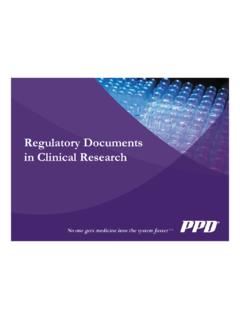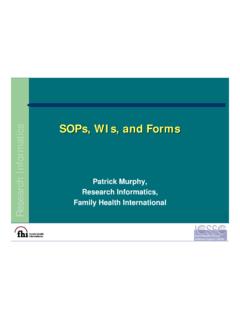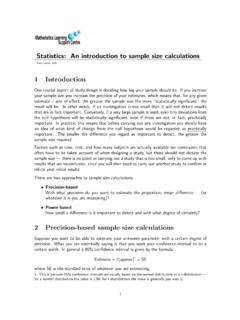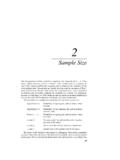Transcription of Sample Size Calculations for Survival Analysis - ICSSC
1 Sample size Calculations for Survival Analysis Mark A. Weaver, PhD. Family Health International Office of AIDS Research, NIH. ICSSC , FHI. Goa, India, September 2009. 1. 1. Design Considerations Will study enroll a fixed number of patients and follow each for some specified period of time? Or, will study continue until a sufficient number of events have been observed? Will any interim analyses be performed? 2. 2. Components in Sample size Calculations 1. Null hypothesis to be tested 2. Test statistic 3. Assumed effect size 4. size of the test (significance level, ). 5. Desired power 6. Sample size (in terms of number of events).
2 7. Probability of an event during study 8. Expected rate of loss 9. Sample size (in terms of number of patients). 10. Adjustments for interim analyses 3. 3. Null Hypothesis to be Tested Recall for log-rank tests H0: S1(t) = S2(t), for all t . H0: h1(t) = h2(t), for all t . H0: h1(t) / h2(t) = 1, for all t . H0: HR = 1, where HR = h1(t) / h2(t) for all t assuming proportional hazards 4. 4. Test Statistic Can use either 1. log-rank test (or some variation thereof) or 2. HR estimated from Cox model to test the null hypothesis of no difference 5. 5. Effect size Assume proportional hazards Hazard ratio: HR = h1(t) / h2(t).
3 HR = 1 implies no difference between treatments HR > 1 implies Survival is longer on treatment 2. HR < 1 implies Survival is longer on treatment 1. Want to base Sample size Calculations on having sufficient power to detect some minimally clinically important effect, which may have no relation to the actual treatment effect , maybe a 30% reduction in incidence (HR = ). would be clinically meaningful 6. 6. Significance Level Magic number: = (two-sided). other values can be used, but should be justified , could use = if very strong evidence of a treatment effect is desired , could use = if type I error presents little risk z /2.
4 7. 7. Power Power: typically desire power of at least 80%, 90%, or 95%. Recall that for means and proportions, power is a function of Sample size However, for Survival data, power is entirely driven by number of events Power z . 80% 90% 95% 8. 8. Required Number of Events events =. (z / 2 + z ). 2. 1 2 (log HR )2. z /2 and z are standard normal percentiles See tables previous 2 slides 1 and 2 are the proportions to be allocated to groups 1 and 2. for equal allocation 1 = 2 = 1/2. 9. 9. Example: Required Number of Events events =. (z / 2 + z ). 2. 1 2 (log HR )2. Suppose = and = (power = 90%).
5 Z /2 = , z = Equal allocation ( 1 * 2 = ). HR Events Required *. 845. 331. 88. *Always round Calculations up. Why? Note: have not yet discussed background event rate 10. 10. Components in Sample size Calculations 1. Null hypothesis to be tested 2. Test statistic 3. Assumed effect size 4. size of the test (significance level, ). 5. Desired power 6. Sample size (in terms of number of events). 7. Probability of an event during study 8. Expected rate of loss 9. Sample size (in terms of number of patients). 10. Adjustments for interim analyses 11. 11. How Many People? Suppose we designed study to have 90% power to detect a hazard ratio of ( , a 50%.)
6 Reduction in event rate). We have already determined that this would require observing 88 events But, how many people should we plan to enroll to get that number of events? 12. 12. A Simplification Will consider only case in which each patient is to be followed for some specified period of time, T. More general case: patients recruited during accrual period of length a after recruitment ends, additional follow-up of length f patients remain in study from time recruited until end of study first patient in is followed for a + f last patient in is followed for f for Calculations in general case, see , Collett (1994), Modelling Survival Data in Medical Research 13.
7 13. Calculating Number of People Need to consider probability of event during study Once we have this probability, total number of people can then essentially be calculated as events n=. Pr{ event }. ignoring loss for now . 14. 14. Probability of an Event (. Pr{event} = 1 1S1 (T ) + 2 S 2 (T ) ). Recall that 1 and 2 are the proportions to be allocated to groups 1 and 2. for equal allocation 1 = 2 = . How do we get values for S1(T) and S2(T)? 15. 15. Assume Exponential Survival Times For exponential failure times, IR = t , if IR = 10 events / 100 p-y = events / p-y, then t = at t = 1 year Recall that S(t) = exp{ - t }.
8 We can use an assumed IR to calculate an assumed failure probability for SS Calculations , if *1 = , then S(1) = exp{ } = Thus, we assume that 1 = of participants will have an event within 1 year 16. 16. Example 1. One-year study (T = 1), equal allocation Suppose have previous estimate of IR for control group of 10 / 100 p-y, or .1 / p-y For power Calculations , assume HR = S1(1) = exp( ) = S2(1) = exp( * ) = Pr{ event } = 1 ( + )/2 = n = events / Pr{ event } = 88 / = 1223. 612 / group 17. 17. Example 2. 6 month study (T = ), equal allocation As before, estimate of IR for control group is.
9 1 events / p-y (or .05 events / person-half-year). For power Calculations , assume HR = S1( ) = exp( ) = S2( ) = exp( * ) = Pr{ event } = 1 ( + )/2 = n = events / Pr{ event } = 88 / = 2380. 1190 / group 18. 18. What About Loss? Approximate method for handling loss nadj = n / (1 loss). Example, assume at most 10% loss From Example 1, nadj = 612 / = 680 per group From Example 2, nadj = 1190 / = 1323 per group 19. 19. Adjusting for Interim Analyses Conducting multiple interim analyses entails a slight loss of power Must inflate Sample size to account for this Sample size multipliers for 2-sided = Number of O'Brien-Fleming Pocock planned Power = Power = Power = Power =.
10 Analyses 80% 90% 80% 90%. 2 3 4 5 20. 20. Example of Interim Analysis Adjustment Suppose plan for 4 analyses (3 interim plus final). Decide to use a Pocock boundary Number of events required = 88 * = 104. Number of people required = 104 / = 1444. Adjusting for 10% LTF = 1444 / = 1604. 802 per group With O-F boundary, verify that would require about 695 per group Compare these to 680 per group without interim analyses 21. 21. Questions? Don't worry, you'll get to try one on your own . but you won't have to do it by hand.. 22. 22.














